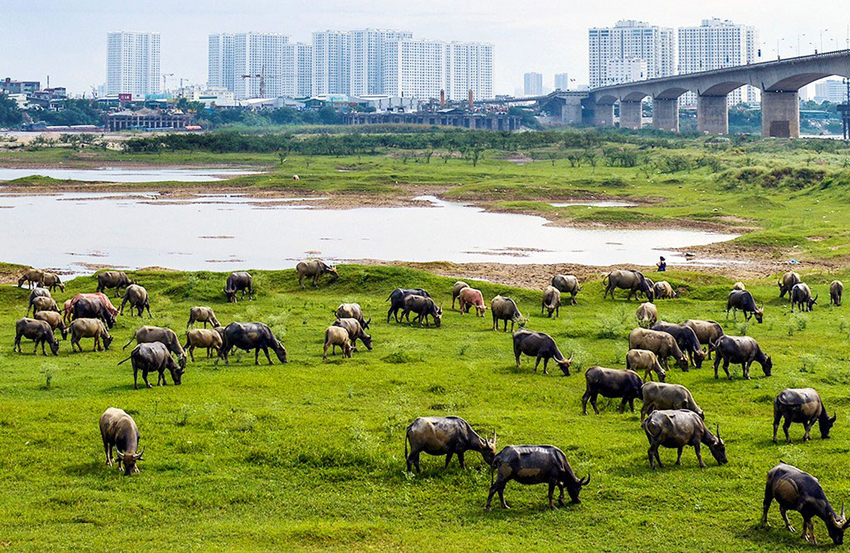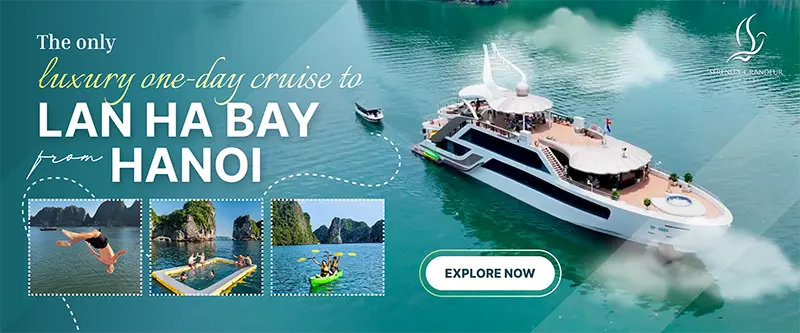About Vietnam

So why should you visit Vietnam?
Despite a notoriously bloody history with the West, Vietnam remains hugely welcoming to Westerners. Even in the biggest cities, tourists will find themselves approached by groups of students eager to perfect their English.
The Vietnamese take great pride in their nationality and culture and will be very grateful of any attempts at the language or to learn more about the county.
Vietnam’s national dish is pho, a beef or chicken soup with noodles, is available almost everywhere you look.
The country has a wide variety of food suiting all tastes and diets, with the influence of the French occupation leaving a mark on Vietnam’s menus.
The Vietnamese are one of Asia’s biggest beer drinkers, largely due to the presence of bia hoi (very cheap homemade ‘air beer’) on many street corners across the country.
Being the world’s second largest coffee exporter, the drink is also hugely popular, although Vietnamese tradition means it is usually served very strong and with lots of sugar.
Where to go in Vietnam
As a first time visitor, you are almost inevitably bound to land in either Hanoi or Ho Chi Minh. Hanoi was our first port of call with Ho Chi Minh following immediately after.
These two rivalling cities are perennial travellers faves with great accommodations options and other good infrastructure geared towards travellers’ needs, both having great transport connections with all the major destinations throughout the country and mouth-watering cuisine from every corner of the country.
Bustling local markets, freshly brewed and high quality coffee, an abundance of museums – these two are definitely not to be missed!
Hanoi
For us, Hanoi remains the city of the iconic red bridge over the lake, narrow streets of the Old Quarter and strange lotus seeds beverages.
It is actually one of the most stereotypical ‘Asian’ cities, with a huge array of sounds, smells and sights overwhelming any first-time visitor.
Centred around Hoan Kiem Lake, the old town is easily discovered on foot, whilst the lakefront gardens are a peaceful haven to escape the madness of the city’s streets.
Visits to the Ho Chi Minh Mausoleum and the former Hoa Lo Prison (nicknamed the Hanoi Hilton by American POWs) offer insight into the country’s recent history whilst the water puppet theatre showcases one of Vietnam’s long-established traditions.
Ho Chi Minh
Resembling a European city with a dominating skyline but with a wide variety of cultures co-existing under the surface, Hi Chi Minh City seems a world away.
For anyone looking to understand more about the nation’s fierce patriotism and recent history, the city’s War Remnants Museum is a must-see.
The sombre yet compelling exhibitions on the wars with France and the US, including the human and environmental impacts of these conflicts, leave a lasting impression.
Ha Long Bay
You may not be lucky to hit the best weather while visiting Ha Long, but even with the rain the bay dotted with countless islands looks terrific – it was raining cats and dogs during our first visit in August, but we still enjoyed the trip.
Ha Long Bay can be reached directly from Hanoi, either with a tour or independently, or from Vietnam’s third largest city, Haiphong. The UNESCO world heritage sight consists of almost 2,000 islands that remain best absorbed through an overnight boat cruise.
Cat Ba Island
Cat Ba isn’t like anywhere else on the planet. It’s raw and rugged. Cat Ba is the neighborhood of Ha Long Bay, therefore, not so many people have chosen Cat Ba as a destination to reach instead.
It’s the same as when you are so charming and beautiful but you live next to a Miss World. No one would spend time to glance at you when they come across the neighbor. They are too busy looking for the Miss World.
Sapa
A trekking lover’s paradise, Sapa is the major city in the far North of Vietnam.
The stunning countryside and the chance to meet the region’s indigenous people do draw here quite a lot of tourists, but regardless the fact, Sapa somehow remains surprisingly atmospheric place to explore with that rare feeling ‘out of the beaten track’.
Trekking is the main activity here and a highlight of many tourists’ stay. It can get chilly so ensure to bring warm clothes.
Excellent treks are also available in Bac Ha, but the town’s biggest attraction is the Sunday market which brings thousands of locals, many of the women in traditional dress, to trade the region’s famous produce.
Where to go if you like...
The imperial heritage, eternal spring or beach holidays local style? You can find it all in Vietnam, too!Beaches
Danang is the largest city in Central Vietnam and a great base from which to explore the central region.
The area’s best beaches are to the East of the centre, including the famous China Beach (My Kye).
The city becomes very hot and dry during the summer, with temperatures hitting 40°C and tropical storms common in October and November.
Just outside the city centre lies the Marble Mountains, the largest of which is Thuy Son, where you can find Am Phu Cave, a series of caves depicting a Buddhist re-imagining of hell.
The beach town of Nha Trang is hugely popular in summer, so worth booking ahead at this time.
The area is best avoided between October and December when the monsoon season makes it difficult to access the excellent diving spots.
The town is a great spot to relax for a few days but always leave your valuables in the hotel safe as although the town is generally safe for tourists, petty crime at the beach can happen.
The low-key charms of Phan Thiet – and its fresh cheap seafood – attract hordes of local tourists, but the main draw point in the area is definitely Mui Ne, the kite-surfers capital of the world.Islands
Vietnam may not be the first SEA country which comes to your mind when you are searching for tropical paradise islands. Not yet, at least. Check these island destination before the hordes of tourist come!
Although closer to Cambodia, the most famous Vietnamese island is Phu Quoc island, which boasts idyllic beaches, the best of which is Sao Beach in the South East.
There are also good diving and snorkelling opportunities around the island. As this is a fairly small island and a popular tourist destination, booking ahead is highly recommended.
The Con Dao islands may be the former home of a prison but they offer some of the best snorkelling in Vietnam and if you're lucky, you may spot a turtle.
The majority of the islands are covered in thick jungle so it is possible to combine trekking with a beach break.
Anyone looking to escape the crowds on the mainland may wish to discover islands such as Hai Tac and Nam Du, where it is still possible to enjoy some of the country’s best beaches all to yourself.
Heritage cities
Hue, the former imperial capital, boasts the magnificent Imperial Citadel. A huge series of palaces, temples and gardens used to be home to the Nguyen dynasty and are well worth spending a day exploring.
Another day can be spent visiting the nearby tombs of past emperors. Closer to temples or palaces than tombs, these are best accessed by boat or bicycle.
Hoi An is a paradise for those who love food or shopping, its charming lantern-lit streets are filled with stalls selling food and crafts. The ancient Cham ruins at My Son, a UNESCO world heritage site from the 4th century, are easily accessible for a day trip.
The town of Dalat is situated in the Southern countryside and has a distinctly European feel.
The French escaped the heat here and it remains a popular destination for Vietnamese. More laid-back than many other parts of Vietnam, there is also plenty to do in the nearby hills including the stunning cable car to Thien Vien True Lam Monastery.
Although the town is usually warm and dry, it can become cooler at night.
Nature
Vietnam has 30 national parks located mostly in the north and in the south with only 7 of them found in the narrow central part of the country.
Featuring an abundance of wild life, lush tropical greenery and some of the most imposing caves in the world, national parks in Vietnam are an ultimate destination for caving, trekking, biking, canoeing and much more.
Probably the best place in the country for bird watching, Cuc Phuong, Vietnam’s first and largest national park, remains well off-the-beaten path destination.
Though it is possible to visit as a day trip from Hanoi, we recommend staying in the park for a couple of days.
There are even more spectacular vistas of karst mountains around Tam Coc village in the province of Ninh Binh, home to Cuc Phuong NP.
Hiking and canoeing are probably the two most popular activities people come for to Cat Tien, easily reachable from Ho-Chi-Minh City. The park boasts an astonishing bio-diversity and is kept in a great condition.
Located close to Hoi An, the Cham island is the greenest place in the country and definitely well worth a short boat trip, although best avoided between September and April when weather conditions can make access difficult.
Read more →
- → Cat Ba Island, Vietnam - an unforgettable holiday
- → The top 15 hotels in Cat Ba Island
- → Lan Ha Bay – the forgotten paradise
★ Leave a review!


